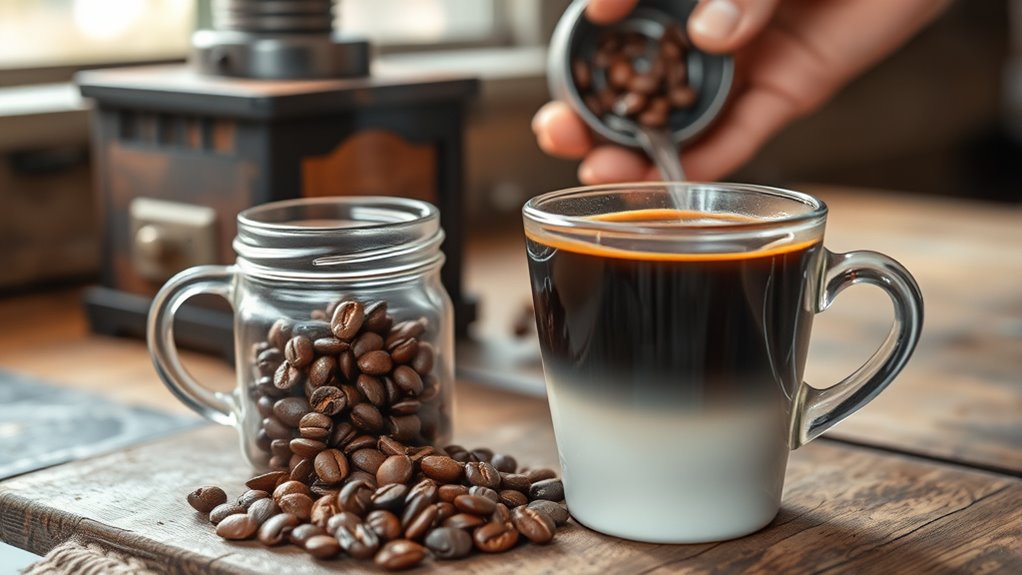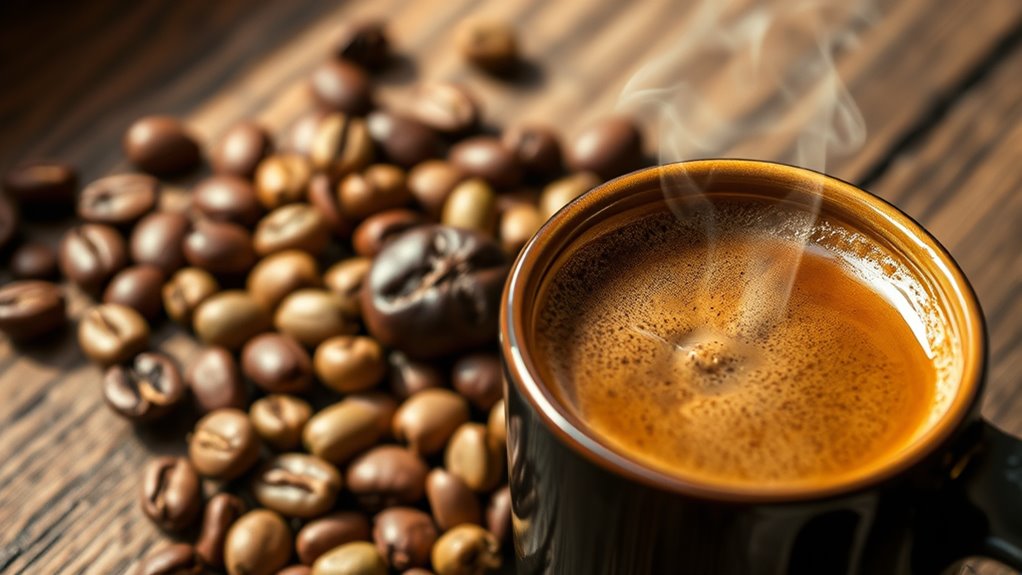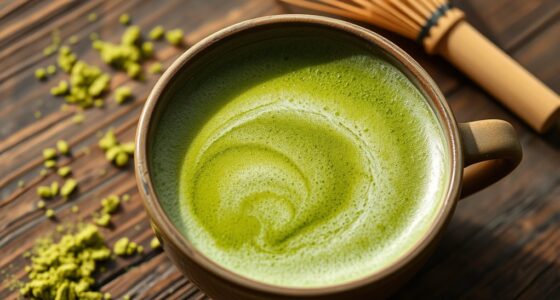From bean to cup, your coffee journey starts with careful cultivation, where farmers pick ripe cherries at just the right time. These cherries are then processed through dry or wet methods, sorted, graded, and roasted to develop rich aromas. Once brewed using your preferred method, hot water extracts flavors from ground beans, revealing the complex tastes that make each cup special. If you stay curious, you’ll discover all the steps that make your coffee experience truly extraordinary.
Key Takeaways
- Coffee cultivation involves careful selection and harvesting of ripe cherries to ensure high-quality beans.
- Processing methods like dry and wet processing influence the flavor profile of the beans.
- Sorting, grading, and hulling improve bean quality before shipping to roasters.
- Roasting develops the beans’ aroma and flavor through specific temperature and timing profiles.
- Brewing techniques extract flavors from ground beans, completing the journey from bean to cup.

Coffee begins its journey long before it reaches your cup, starting with the careful cultivation of coffee beans. You mightn’t realize it, but every sip you take is the result of meticulous planning and effort by farmers who tend to coffee plants that thrive in specific climates. These plants require the right altitude, temperature, and rainfall to produce high-quality beans. During harvest season, pickers carefully hand-select ripe cherries, ensuring only the best fruit makes it into the processing stage. This attention to detail is essential because the quality of the beans directly impacts the flavor of your coffee.
Every sip reflects the meticulous care of farmers selecting ripe cherries for high-quality coffee.
Once harvested, the beans undergo processing, which can vary depending on the method used. You might be surprised to learn that there are two main types: dry processing and wet processing. In dry processing, cherries are spread out in the sun to dry naturally, which can give the beans a distinct, sometimes fruity character. Wet processing involves pulping the cherries to remove the outer layers and then fermenting the beans to eliminate remaining mucilage. This method often results in a cleaner, brighter flavor profile.
After processing, the beans are dried to a specific moisture level, then sorted and graded based on size, weight, and defect count. This grading helps determine the final quality and price of the beans. Once sorted, the beans are hulled to remove the parchment layer if they’re processed as wet-processed beans. They’re then polished and checked for defects, ensuring only the best beans move forward.
These green coffee beans are then bagged and shipped across the world to roasters like yourself, who transform them into the aromatic beans you recognize. Roasting is an art, where temperature and timing bring out the unique flavors locked inside each bean. Whether light, medium, or dark, the roast profile dictates the taste, aroma, and body of your coffee.
After roasting, beans are ground to suit your brewing method—be it French press, espresso, or drip. The grind size influences how quickly water extracts flavors from the beans, affecting the overall taste. When you brew your coffee, hot water interacts with the ground beans, extracting oils, acids, and compounds that create the complex flavors you enjoy.
This entire process, from the careful cultivation to the final brew, underscores how much effort goes into each cup. When you take that first sip, remember it’s the culmination of countless steps, expertise, and passion—delivering the rich, satisfying experience you expect in every cup.
Frequently Asked Questions
What Are the Health Benefits of Drinking Coffee?
You might wonder about the health benefits of drinking coffee. It can boost your energy levels, improve mental alertness, and even enhance physical performance.
Coffee is rich in antioxidants, which help fight free radicals and reduce inflammation. It may lower the risk of certain diseases like Parkinson’s and type 2 diabetes.
Just remember to enjoy it in moderation, as too much caffeine can cause side effects.
How Do Different Brewing Methods Affect Flavor?
You’ll notice that different brewing methods markedly influence coffee’s flavor.
For example, French press produces a rich, full-bodied taste with more oils, while pour-over offers a clean, bright profile by filtering out sediments.
Espresso delivers a concentrated, bold flavor in a small shot, and cold brew results in a smooth, mellow drink with less acidity.
Each method extracts unique flavors, so choose one that matches your taste preferences.
What Is the Environmental Impact of Coffee Production?
You mightn’t realize it, but coffee production impacts the environment considerably. It can lead to deforestation, water pollution, and high water use.
You can reduce your footprint by choosing sustainably grown coffee, supporting farms that use eco-friendly practices, and reducing waste.
How Can I Store Coffee to Maintain Freshness?
They say, “a stitch in time saves nine,” and the same applies to storing coffee. To keep your beans fresh, store them in an airtight container away from light, heat, and moisture.
Avoid the fridge or freezer, as they can cause condensation. Instead, keep your coffee in a cool, dark place, and only grind what you need.
This way, every cup stays fresh and flavorful.
What Are the Best Coffee Varieties for Beginners?
When choosing coffee varieties for beginners, you want options that are easy to enjoy and forgiving. Look for medium roast beans, as they balance flavor without being too bitter or too acidic.
Popular choices include Colombian, Guatemalan, or Brazilian coffees. These beans have smooth, well-rounded profiles, making them perfect for those new to coffee.
Experiment with different brewing methods to find what suits your taste best.
Conclusion
Now that you know the journey from bean to cup, you’ll appreciate every sip even more. Did you know that over 2 billion cups of coffee are enjoyed worldwide each day? That’s like sharing a coffee with the entire population of China daily! So next time you take a drink, remember the incredible process behind it and the countless hands that make each cup possible. Your favorite brew is truly a global masterpiece in every sip.









